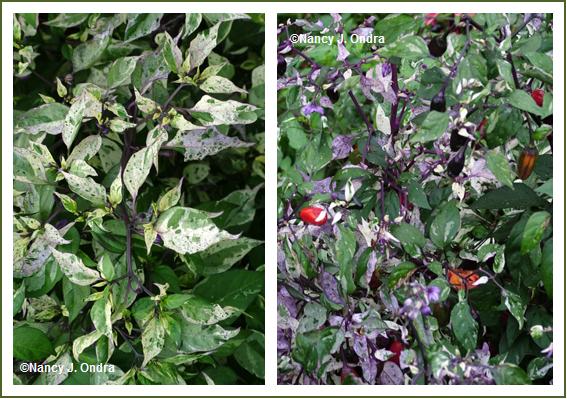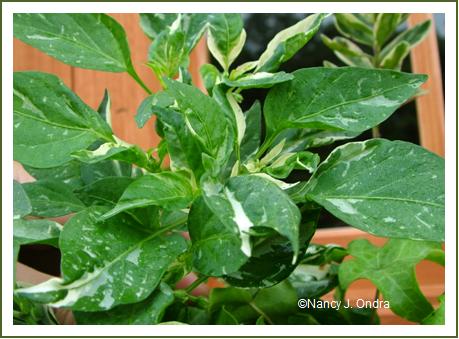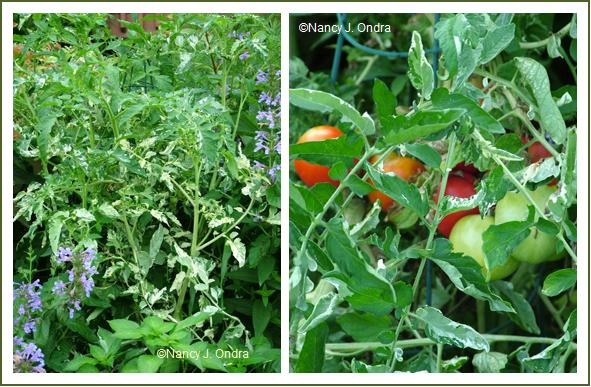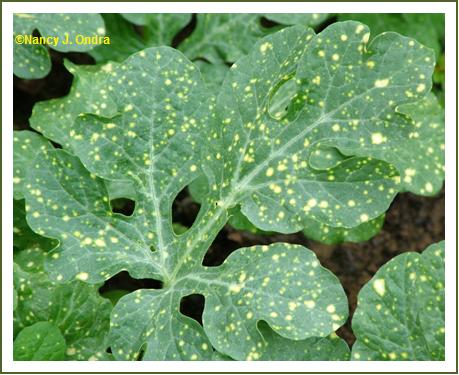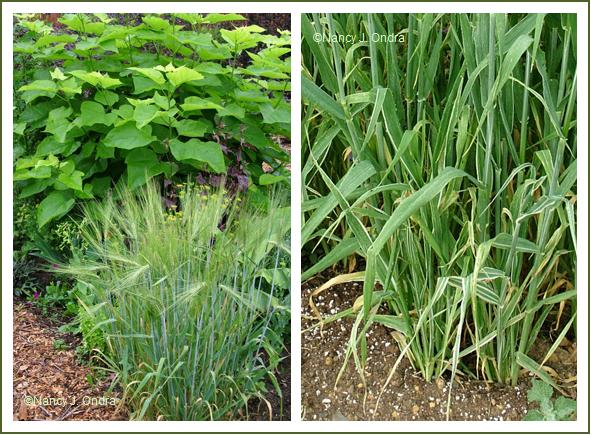I think one of the reasons I took so long to catch on to growing vegetables is that the whole process seemed so serious. All those complicated crop-rotation plans, harvest-date calculations, and problem-solving charts seemed like way too much paperwork and worry. And let’s face it: When you’re used to growing ornamentals, most common vegetable plants aren’t all that much to look at. But if you’re willing to do some hunting, you can find some really outlandish-looking edibles, and it’s hard to take wildly variegated vegetables at all seriously.Hot peppers are a gold mine for gardeners seeking good-looking plants. Even the green-leaved ones can be pretty for their fruits, but the purple-leaved varieties are even showier, and the variegates are equally eye-catching. The photo at the top of this post shows ‘Tricolor Variegata’ (also sold as ‘Trifetti’), with green-, white-and-purple leaves and deep purple fruits that mature to bright red. Heirloom ‘Fish’, shown below, has somewhat larger green leaves splashed with varying amounts of white. Its larger green fruits are also striped with cream, gradually ripening to dark-striped orange and then to solid red. To be honest, I’ve never actually tried eating either of these, but I gather that the fruits of ‘Tricolor Variegata’ are quite hot, while those of ‘Fish’ are somewhat milder. Both are worth trying even just as ornamentals; they grow equally well in the garden and in containers. Underwood Gardens is one source that sells both ‘Tricolor Variegata’ and ‘Fish’.
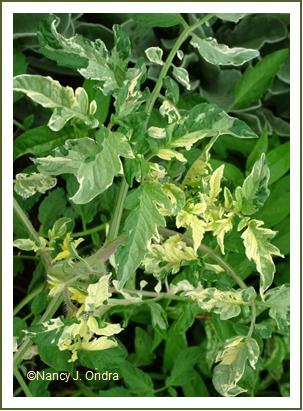 And if you’re going to grow variegated peppers, then of course you must have variegated tomatoes as well. The foliage effect of ‘Variegata’ is evident from the seedling stage and stays quite showy until midsummer. The variegation then mostly disappears with hot weather but returns with the cooler temperatures of fall. I’ve tasted the relatively small fruits and wasn’t impressed with the flavor, though I’ve read that other gardeners think they’re great, so I’ll leave that for you to decide if you try growing it. I haven’t deliberately planted ‘Variegata’ for the last two years, but it keeps coming back from self-sown seed, so I let a few plants stay here and there, just because they’re so neat-looking. You can finally buy seeds of ‘Variegata’ through the Seed Savers Exchange.
And if you’re going to grow variegated peppers, then of course you must have variegated tomatoes as well. The foliage effect of ‘Variegata’ is evident from the seedling stage and stays quite showy until midsummer. The variegation then mostly disappears with hot weather but returns with the cooler temperatures of fall. I’ve tasted the relatively small fruits and wasn’t impressed with the flavor, though I’ve read that other gardeners think they’re great, so I’ll leave that for you to decide if you try growing it. I haven’t deliberately planted ‘Variegata’ for the last two years, but it keeps coming back from self-sown seed, so I let a few plants stay here and there, just because they’re so neat-looking. You can finally buy seeds of ‘Variegata’ through the Seed Savers Exchange.
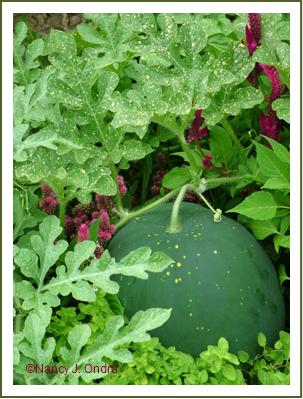 And for dessert? How about ‘Moon and Stars’ watermelon? Just look at that awesome yellow-speckled foliage! The fruits are dotted with yellow spots of varying sizes (hence the variety name), usually much more prominently than the one shown here. It’s getting easier to find the seed of generic ‘Moon and Stars’-type melons through mainstream seed sellers, and specialty suppliers offer several different strains, varying in the shape, size, and flesh color of the fruits. Seed Savers Exchange, for instance, offers Cherokee Strain, with pink-flesh, elongated fruits; Van Doren Strain, with pink-fleshed, oval fruits; and Yellow Fleshed, with (you guessed it) yellow-fleshed, white-seeded, elongated fruits. I don’t know what kind I was growing, since mine had small, round, pink-fleshed fruits, and so did the previous-year’s plants, from which they self-sowed. They were very tasty, whatever they were.
And for dessert? How about ‘Moon and Stars’ watermelon? Just look at that awesome yellow-speckled foliage! The fruits are dotted with yellow spots of varying sizes (hence the variety name), usually much more prominently than the one shown here. It’s getting easier to find the seed of generic ‘Moon and Stars’-type melons through mainstream seed sellers, and specialty suppliers offer several different strains, varying in the shape, size, and flesh color of the fruits. Seed Savers Exchange, for instance, offers Cherokee Strain, with pink-flesh, elongated fruits; Van Doren Strain, with pink-fleshed, oval fruits; and Yellow Fleshed, with (you guessed it) yellow-fleshed, white-seeded, elongated fruits. I don’t know what kind I was growing, since mine had small, round, pink-fleshed fruits, and so did the previous-year’s plants, from which they self-sowed. They were very tasty, whatever they were.
If you’re interested in tracking down other eccentric edibles, you really can’t do better than to join the Seed Savers Exchange. Their retail catalog sells just a sampling of the amazing diversity offered through the Seed Savers Yearbook: 450 newsprint pages packed with well over 10,000 vegetable and fruit listings available from other SSE members. That’s how I originally found the variegated tomato, as well as two other agronomic gems: variegated barleys. Their markings don’t show up well in photos, unfortunately, but I can tell you that ‘Montcalm Mutant’ (below left) had yellow-banded young leaves, while ‘Variegata’ had white-edged foliage. They’re hardly show-stoppers, but the thrill of discovering their existence and acquiring the seed made them worth growing, for me, anyway. I encourage all of you adventurous gardeners to give SSE a try for at least one year, and see if you don’t find some treasures you’d enjoy for yourself.

